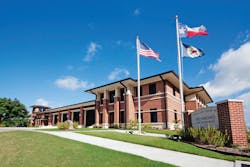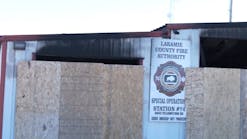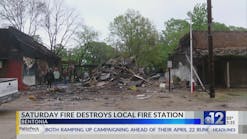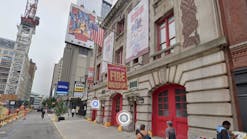“Why can’t we build a fire station for less than $500,000?”
A mayor in a large Midwestern city recently asked this question of his fire chief. The mayor recognized the need for a new fire station, but the cost estimates were more than double what was expected. How could they possibly remodel their other fire stations with those prices? The mayor couldn’t understand why the chief couldn’t just build a house and add a breezeway to a garage for the fire engine.
Why has it become so expensive and complicated to build a fire station? Perhaps the simplest answers are increasing construction costs and the fact that fire departments do a lot more than just fight fires these days.
Building a new station for a career department is also more expensive, but 68 percent of U.S. fire departments are volunteer departments and many in rural areas are without any revenue base. To keep costs down, smaller fire departments frequently opt for manufactured structures or pole barns and often rely on their own skilled volunteers to help build-out their new stations.
Architects respond
When told about the $500,000 question, several architects responded it was difficult to discuss the cost of fire stations without knowing a fire department’s space needs, the location and condition of the site, as well as needed improvements. Total project costs could include land acquisition, financing, professional service fees—architecture, engineering, legal, etc. Labor costs and construction methods can increase the construction costs by as much as 35 percent, especially where project financing includes state or federal funds that require prevailing wages be applied.
When asked about building moderately priced fire stations, Paul Andrew Sgroi, principal, Bernardon, West Chester, PA, responded, “One can certainly build a new station for either $500,000 or $1,000,000 or anything in between, below or above, but the accommodations in the station will be driven by all of the soft costs, site costs, and the value of construction per square foot for that region.”
Sgroi explained if the cost per square foot for hard construction for a station in a particular region was $160 per square foot, a 2,500-square-foot fire station would cost $400,000, excluding soft costs that could easily be another 25 percent of construction costs.
“The question then becomes, ‘What does 2,500 square feet get you?’”, Sgroi said. “Two apparatus bays 70-feet long by 18-feet wide will use 1,260 square feet with the remaining area allocated to important functions such as space dedicated for turnout gear, gear washing and drying, storage, toilet and shower facilities, control/radio room and other critical functions that need to be identified early in the design process.”
Determining the appropriate building program is directly related to the community served, the number of incidents managed, and response time. If the department provides emergency medical services, anticipates future growth and a transition to adding overnight personnel, these aspects must be included in the design plans.
Over the past 30 years, responsibilities of fire departments across America have evolved from primarily fighting fires to vehicle extrications, a range of rescue incidents, advanced emergency medical services, hazmat response, etc. Just as fire trucks now hold additional gear, extrication tools and equipment, the fire station must also accommodate for the storage and repair of equipment, disaster preparedness and training for these incidents.
The early 1990s trend of firefighter fitness that moved workouts in the apparatus bays to designated fitness rooms, are now standard in every fire station submitted for annual Firehouse Station Design Awards programs. (Fitness rooms continue to improve and now include floor space for yoga and core body workouts.) Exhaust systems in apparatus bays have also become standard in new fire stations.
As recently as five years ago, the increasing numbers of cancer in firefighters prompted discussions of designating “zones” in fire stations to help limit personnel’s exposure to carcinogens and toxins upon returning from incidents. Zones in fire stations are now a reality.
Paul Erickson, LeMay Erickson Willcox Architects, has presented and written extensively about “Hot Zone” designs, which he describes as dividing a fire station into three zones and restrict cancer-causing contaminants (Red zones) from living areas (Green zones).
Based on additional research, Erickson also suggests changes to PPE storage and the common practice of storing the gear on racks in the apparatus bay should be updated by moving the gear to another area to reduce exposure. Due to the off-gassing of used turnout gear and degradation by UV exposure, Erickson said that best practices dictate that gear should be concentrated and stored in a separate, enclosed room and served by a dedicated mechanical system with non-recirculating air supply and direct exhaust.
While firefighters’ health and safety is a concern in every fire department, when faced with a tight budget or no budget, but a dire need to expand, what can a fire chief do to solve the challenges of better serving personnel and community economically?
According to representatives from Brown Reynolds Watford Architects, College Station, TX, one of the problems they encounter in working with fire departments about high building costs is when fire departments try to equate residential construction with commercial construction.
Brown Reynolds Watford Architects recommends any department with tight and limited budgets must prioritize their needs. Many stations today are being built between $275 and $400 a square foot. A less expensive approach is a prefabricated wood building, with an insulated shell. This type of building runs between $60 and $70 per square foot. The concrete foundation and interior build-out is additional, however, a simple interior build-out can be $160 to $185 per square foot.
Brown Reynolds Watford Architects also shared that in some situations, a city will do the site clearing and rough grading for site preparation.
The City of Richmond, TX, saved a significant amount of site work costs by performing demolition in-house by their road crews. A city may also provide other items such as waiving fees, or providing and installing meters and taps.
When faced with a limited budget, Brown Reynolds Watford Architects’ suggests three strategies to reduce the cost of a new station:
- Simple form. Keep the design rectilinear, in the shape of a rectangle. Every time the facade changes plain, it adds cost to the construction.
- Wood construction is still the most economical material for the living side of the station. The bays can be load-bearing concrete masonry units (CMU). The CMU serves as an abuse-resistant material that is appropriate for the bays and serves as an exterior material.
- Minimize site paving.
There are a lot of things to consider when designing a new fire station and architects have recommended essential points to consider in a new fire station. These points include:
- The biggest expense in a new fire station is electrical, followed by site work including grading, paving and site utilities.
- The foundations must support substantial concentrated loads. Cracks are not easily (or cheaply) fixed or repaired.
- The station needs to have positive site drainage away from the building. Fire departments are expected to be operational during adverse conditions, which is when their services are critical. Critical operation elements…overhead doors, backup power, etc.
- Life Safety. Smaller stations may sacrifice items like building fire suppression and commercial range hoods. It is important to provide multiple means of egress and appropriate building separations.
- Maintaining clearances and good sight lines for responders. Forcing a reduction in the size of program spaces simply to add other functions can create conflicts within the station and potentially impact safety and response times. A proper space needs assessment must be conducted at the very beginning of the project in order to “right-size” the station.
- Incorporating an efficient thermal envelope to minimize the operational costs of a station. Operational costs over the life of the building can amount to significantly greater expenses than the initial construction cost itself.
- Creating a livable environment that encourages a community of responders to remain committed to and active in the fire company.
Building an affordable building to meet the needs of your department and community is a challenge. If you are part of a small department and recently replaced your fire station, we’d like to hear from you. Please send us your story: [email protected].










